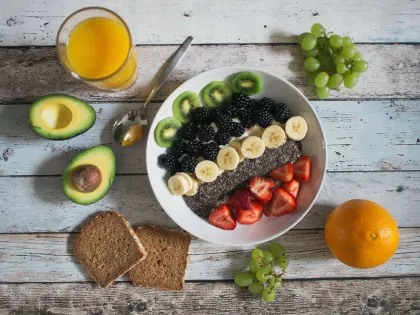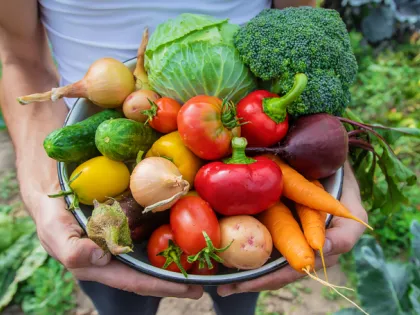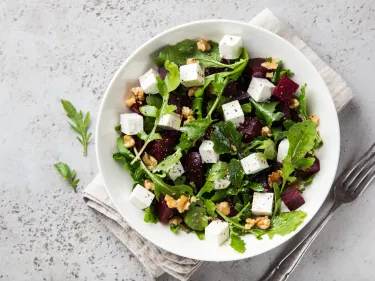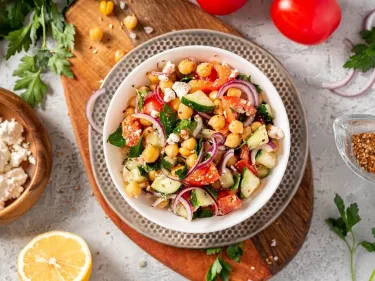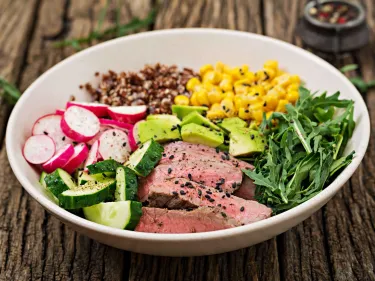Marketing is a powerful tool used by food companies to influence our decisions to buy a particular type of food. We are influenced by the look of foods, the packaging, the information listed on the packet, right down to whether a packet is resealable.
Specific labels and product information must be included on packaged foods, this includes the nutrition information panel and ingredient list. Many companies are also opting to voluntarily use the health star ratings on their products. You can read more about these here.
Images, colours and some of the wording included on a food packet is up to the food manufacturer. In Australia and New Zealand, the Food Standards Code, Standard 1.2.7 is legislation that creates rules around the messages that companies can include on their packaging that might be related to a particular nutrient in that food, and what health claims they can make. These are called nutrition content claims and health claims. These types of messages must meet certain criteria to be included on a label.
A nutrition content claim is a comment, or a message included on a food packet that makes mention of a particular nutrient in a food or focuses on the quality of that nutrient. For example, saying that a product is a good source of fibre is a nutrition related claim. You will see below that wording is particularly important, as the difference between a ‘good’ and an ‘excellent’ source of a nutrient is related to the actual quantity of that nutrient in the food.
A health claim is a comment or message that suggests that by eating that food it will have some effect on your health. For example, a label on rolled oats that says it is high in beta-glucan which will lower your cholesterol is a health-related claim.
Do nutrition content claims and health claims mean that a food is better for you?
Nutrition content claims and health claims can help people identify attributes of a product that might be relevant for their health or nutrition goals. It can also be used by companies as an opportunity to attach themselves to trending ideas and claims, for example ‘plant-based’.
Guidelines around what companies can say about a food to influence your decision making are designed to protect the consumer. However, how a company uses these labels can be misleading, or used to appeal to a particular category of customer.
Monitoring and enforcing food labelling requirements is difficult as there are always new foods being added to the market and some can slip under the radar. In one study that looked at ultra-processed foods (breakfast cereals, snacks and confectionary items, selected beverages, condiments and liquid breakfast meals) in Australia and evaluated their nutrition and health claims and marketing against accepted standards and legislation, they found that 59% of products they tested made nutrition or health claims. However, only 18% of the nutrition claims were correct, and 25% of the health claims were correct.
Common nutrition content claims and their meaning:
Reduced or Light/Lite: a food that contains at least 25% more or less of that nutrient than the reference food*.
This is commonly used in relation to energy, sugar and fat.
Low fat:
- The product contains no more than 3g per 100g of fat
Good to note that low fat and reduced/ light foods don’t mean the same thing. For example, a Light/reduced fat version of a reference food may still have 12g/100g of fat, compared to the reference food which has 16g/100g. Whereas a low-fat version of that food would only contain 3g/100g of fat.
Dietary fibre:
- A good source of fibre: one serving contains more than 4g per serve
- An excellent source of fibre: one serving contains more than 7g per serve
Current recommendations suggest that if choosing foods based on fibre content, then aim for a food that has more than 3g/ serve of fibre. This is a good strategy to help boost your fibre intake.
Protein:
- Contains protein: a food contains at least 5g of protein per serve
- Good source of protein: a food contains at least 10g protein per serve
Salt/Sodium
- Low salt/sodium: a food contains less than 120mg of sodium per 100mL or less than 120mg per 100g
- No added sodium: a food contains no added salt, and the ingredients contain no added salt
One teaspoon of salt, which roughly weighs 6g contains 2000mg of sodium, which is the amount of sodium that we are encouraged not to exceed, due to its impact on cardiovascular health. Most people consume more than this amount, daily. Looking for low salt/sodium or no added sodium/salt foods is useful for people trying to limit the amount of salt and sodium they consume. However, this information is beneficial for most people, as reducing salt intakes helps with lowering blood pressure, important in our long-term cardiovascular health.
Saturated fatty acids
- Low in saturated fat: a food contains less than 0.75g/100mL for liquids, or less than 1.5g/100g if it’s a solid food
- Low proportion of saturated fat: <28% of the total fat in a product comes from saturated fatty acids.
Sugars
- Low sugar: a food contains less than 2.5g/100mL ifor liquids or less than 5g/100g if it’s a solid food
- No added sugar: a food contains no added sugars, this includes no added sugar, honey, malt or malt extracts. It also cannot contain concentrated or deionised fruit juice (except in certain drinks).
- Unsweetened: a food can be labelled as unsweetened when it meets the criteria of having no added sugar, and it must also not include other types of sweeteners e.g. sorbitol, mannitol or xylitol
Energy
- Reduced/lite: contains at least 25% less energy than the reference food
- Diet: The food has an agreed level of nutrients, and the average content of the food is no more than 80kJ/100mL for a liquid food, or 170kJ/100g for solid food OR it contains less than 40% less energy than its reference food.
Vitamins and minerals:
- If a vitamin or mineral, such as calcium or iron are listed on the packaging of a food, the food must be able to show that a serving size contains equal to or greater than 25% of the Recommended Dietary Intake (RDI) or other nutrient reference value used for that vitamin or mineral.
This is useful for people who, in working with a dietitian have identified that they need to focus on including foods that are higher in certain nutrients.
* A reference food is a food that for all intents and purposes is the same food that the claim is being made about e.g. soy milk v. lite soy milk, without modifications, or could be considered a substitute for the food (being from the same food group) e.g. soy milk v. cow’s milk.
Other nutrition content claims:
Nutrition content claims can also be made about Gluten, Glycaemic index, Lactose, Mono-unsaturated fat, Omega-3, Omega-6 and Omega-9 content and Potassium
Health claims:
There are strict criteria around making health claims. You can read the rules around making health claims here.




